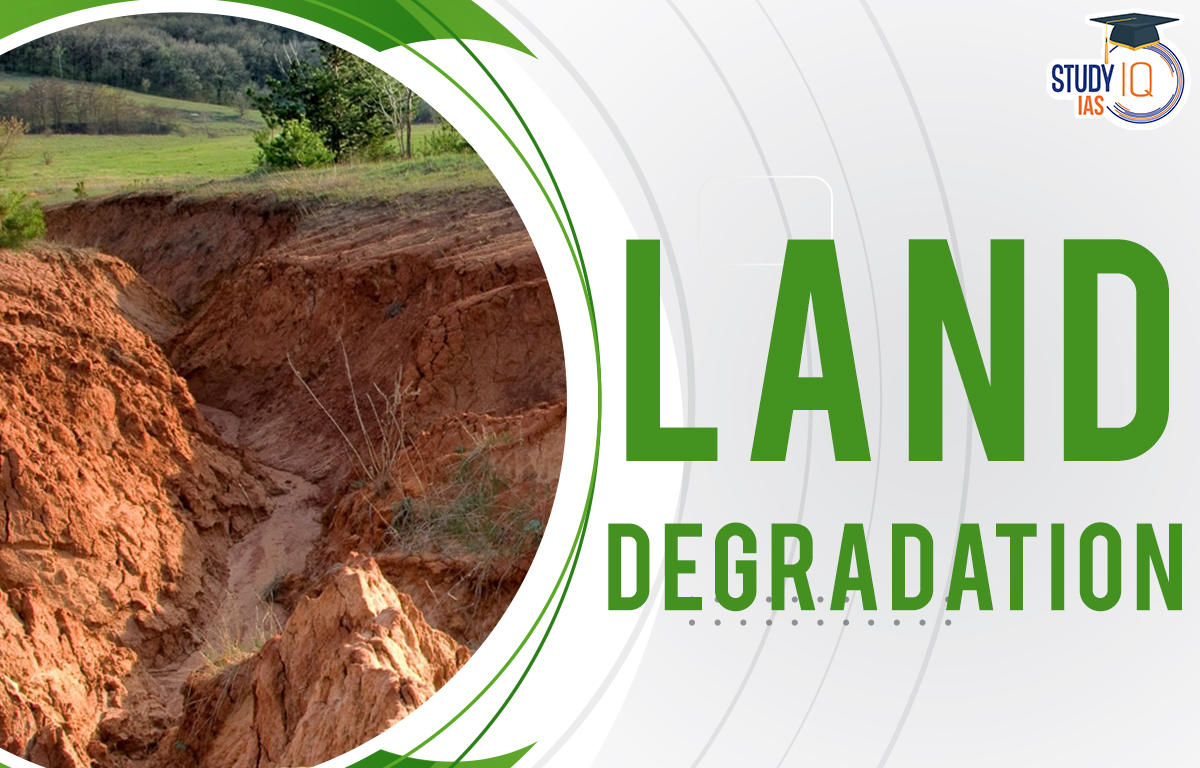Table of Contents
Land degradation is caused by multiple forces, including extreme weather conditions, particularly drought. Much like air and water, land is an essential resource for humankind. Food insecurity, rising food costs, climate change, environmental dangers, the loss of biodiversity, and ecosystem services are just a few of the ways that everyone is impacted by land degradation, which is the deterioration or loss of the productive potential of the soils for the present and the future.
Land Degradation Meaning
Land Degradation occurs when its quality is reduced due to either natural or human reasons. Loss of productivity, biodiversity, and ecosystem services could come from this, which could have a big effect on the environment and civilization. Deforestation, excessive grazing, erosion, pollution, urbanization, and climate change are some typical causes of land degradation.
Land Degradation can reduce its fertility, capacity to support crops, and capacity to feed cattle, all of which can have a considerable effect on regional economies and food security. Environmental effects from land degradation might include soil erosion, biodiversity loss, and lowered water quality. These effects, such as flooding, drought, and desertification, can worsen the effects of climate change and contribute to it.
Land Degradation Causes
- Unsustainable Agriculture:
- Monoculture farming practices.
- Overuse of chemical fertilizers and pesticides.
- Improper irrigation techniques.
- Poor soil management.
- Deforestation:
- Clearing forests for agriculture, logging, and urbanization.
- Disrupts ecosystems and increases soil erosion.
- Alters water cycles and reduces biodiversity.
- Overgrazing:
- Excessive grazing by livestock.
- Leads to vegetation degradation.
- Causes soil compaction, erosion, and loss of fertility.
- Urbanization:
- Expansion of cities and infrastructure.
- Converts productive land into impervious surfaces.
- Results in soil sealing and disrupts water cycles.
- Mining:
- Extraction of minerals and resources.
- Causes habitat destruction and deforestation.
- Contaminates soil and water with toxic chemicals.
- Land Pollution:
- Industrial waste disposal.
- Pesticides, heavy metals, and other pollutants contaminate soil.
- Renders land unsuitable for agriculture and poses health risks.
- Climate Change:
- Alters temperature and precipitation patterns.
- Increases frequency of extreme weather events.
- Exacerbates processes such as desertification and soil erosion.
- Soil Mismanagement:
- Improper land-use planning.
- Inadequate soil conservation practices.
- Lack of land-use regulations.
- Intensifies erosion and habitat destruction.
Types of Land Degradation
Land degradation refers to the deterioration of land quality and productivity. There are various types of land degradation, each caused by different factors and processes. Here are some of the main types:
| Type of Land Degradation | Description |
|---|---|
| Soil Erosion | Topsoil removal by wind or water, often due to unsustainable farming practices, deforestation, or natural disasters. |
| Desertification | Transformation of fertile land into desert, typically caused by climate change, overgrazing, deforestation, and unsustainable agriculture. |
| Salinization | Accumulation of salts in the soil due to irrigation with saline water, making it unsuitable for plant growth. |
| Soil Compaction | Compression of soil particles, reducing pore space and limiting air, water, and nutrient movement, often caused by heavy machinery, grazing, or urbanization. |
| Loss of Soil Fertility | Decline in soil fertility due to overuse of chemical fertilizers, monoculture farming, and poor soil management practices. |
| Deforestation | Removal of forests for agriculture, logging, or urbanization, leading to soil erosion, disrupted water cycles, and biodiversity loss. |
| Urbanization | Expansion of cities and infrastructure, resulting in the loss of productive land, disruption of ecosystems, and increased pollution. |
| Mining | Extraction industries causing land degradation through vegetation removal, soil erosion, contamination, and alteration of landscapes. |
| Land Pollution | Contamination of land by industrial chemicals, pesticides, heavy metals, or hazardous waste, rendering it unsuitable for productive use. |
| Overgrazing | Excessive grazing leading to vegetation degradation, soil erosion, and loss of biodiversity on pastureland. |
Land Degradation Effects
Agriculture productivity is threatened by land deterioration. It worsens soil health, which has an effect on rural residents’ quality of life. It is causing climate change events to worsen, which is leading to even more damage. Degraded land, for instance, loses its ability to absorb carbon dioxide (CO2), the main greenhouse gas contributing to the severity of global warming.
Surface and groundwater resources have declined in quantity and quality as a result of land degradation. Under the best-case scenario of 1.5 deg-C warming, the population of dry land that is susceptible to water stress and drought intensity is predicted to reach 178 million by 2050. The ability of individuals and communities to combat climate change is impacted by insecure land tenure, which puts that effort at risk due to land degradation.
Land Degradation Neutrality
Land degradation neutrality (LDN) is a goal of the UNCCD to stop and reverse the degradation of land. LDN is defined as a state where the amount and quality of land resources that support ecosystem function and services remain stable or increase within specified temporal and spatial scales and ecosystems. LDN is based on the concept of “zero net land degradation”.
LDN is part of the 2030 Agenda for Sustainable Development and is enshrined in Target 15.3, which aims to combat desertification and restore degraded land and soil by 2030. LDN objectives include:
- Maintaining or improving the sustainable delivery of ecosystem services
- Maintaining or improving land productivity to enhance global food security
- Increasing the resilience of land and the populations dependent on it
Land Degradation in India
In India, land degradation affects 120.7 million hectares of land, primarily caused by water and wind erosion accounting for 85.7 million hectares. Agricultural land and forests are the most common types of degraded land, with other forms including physical, chemical, and biological degradation. Both climate change and human activities contribute to land degradation, leading to decreased productivity, health, and biodiversity of the land.
According to data from the United Nations Convention to Combat Desertification (UNCCD), 30.51 million hectares of India’s total reported land was degraded between 2015 and 2019, representing 9.45 percent of the country’s landmass as of 2019.
To address this issue, the Space Applications Centre (SAC) in Ahmedabad has developed an online portal to visualize degraded areas of land and the processes causing degradation.
Various strategies have been implemented to mitigate land degradation, including:
- Rooftop rainwater harvesting: In regions like Junagarh, Gujarat, small houses utilize rainwater harvesting reservoirs for household chores, contributing to water conservation efforts.
- Zero Budget Natural Farming (ZBNF): This approach guides farmers towards sustainable farming practices that enhance soil fertility and minimize production costs.
- Soil Health Cards (SHC): Under this scheme, farmers receive information about the condition of their soils, enabling them to implement measures to restore soil fertility and health.
Land Degradation Prevention
Conservation and restoration initiatives, such as reforestation, erosion control, and sustainable agriculture methods, can be used to combat land degradation. Additional measures, such as restricting deforestation and enhancing waste management, can be taken to minimize the causes of land degradation.
Land Degradation UPSC
The term “land degradation” describes the deterioration of the condition of the land, which can be brought on by human activity or by natural processes such soil erosion or climate change. The causes and effects of land degradation may be covered in the UPSC exam. Studying land degradation for the UPSC exam is crucial because it has a big impact on environmental preservation and sustainable development. Students can read all the details related to UPSC visiting the official website of StudyIQ UPSC Online Coaching.


 Wholesale Price Index (WPI) 2024 Latest ...
Wholesale Price Index (WPI) 2024 Latest ...
 Index of Industrial Production 2024, For...
Index of Industrial Production 2024, For...
 Unemployment Rate in India, Current Rate...
Unemployment Rate in India, Current Rate...

















